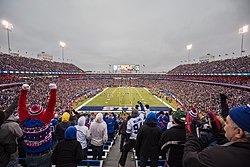Rich Stadium
| "The Ralph" "The Cap" | |
 |
|
 |
|
| Former names | Rich Stadium (1973–1999) Ralph Wilson Stadium (1999–2016) |
|---|---|
| Address | 1 Bills Drive |
| Location | Orchard Park, New York |
| Coordinates | 42°46′26″N 78°47′13″W / 42.774°N 78.787°WCoordinates: 42°46′26″N 78°47′13″W / 42.774°N 78.787°W |
| Owner | Erie County |
| Operator | Erie County |
| Capacity | 71,608 (current) |
| Surface | A-Turf Titan 50 (2011–present) AstroPlay (2003–2010) AstroTurf (1973–2002) |
| Construction | |
| Broke ground | April 4, 1972 |
| Opened | August 17, 1973 |
| Construction cost | US$22 million (1973) ($119 million in 2017 dollars) |
| Architect |
HNTB Populous (2013 renovation) |
| Structural engineer | David M. Berg & Associates Inc. |
| General contractor | Frank Schoenle Construction |
| Tenants | |
| Buffalo Bills (NFL) (1973–present) | |
New Era Field, originally Rich Stadium and formerly known as Ralph Wilson Stadium, is a stadium in Orchard Park, New York, a suburb south of Buffalo. Opened in 1973, it is the home of the Buffalo Bills of the National Football League (NFL). The stadium was renamed in 1998 for team founder and then-owner Ralph Wilson (1918–2014).
An original franchise of the American Football League in 1960, the Buffalo Bills played their first thirteen seasons at War Memorial Stadium, a multi-use WPA project stadium that opened in 1938, located on Buffalo's East Side. While suitable for AFL play in the 1960s, the "Rockpile" (as the stadium came to be nicknamed), was in disrepair, in a neighborhood increasingly subject to white flight and urban decay, and, with a capacity of under 47,000, undersized for a National Football League team. The league mandate instituted after the AFL–NFL merger of 1970 dictated a minimum of 50,000 seats.
In early 1971, owner Ralph Wilson was exploring options to relocate the team, possibly to Seattle, with other cities such as Memphis and Tampa soon expressing interest as well. The potential loss of the team hastened the stadium project and Rich Stadium opened in 1973. The location and construction of the stadium in Erie County were the source of years of litigation, which ended with a financial settlement for a developer who had planned to erect a domed stadium in Lancaster. However, plans changed because it was not wanted to be close to Lancaster High School. The stadium was ultimately built by Frank Schoenle and his construction company. Stadium bonds were approved by the county legislature in September 1971.
...
Wikipedia
